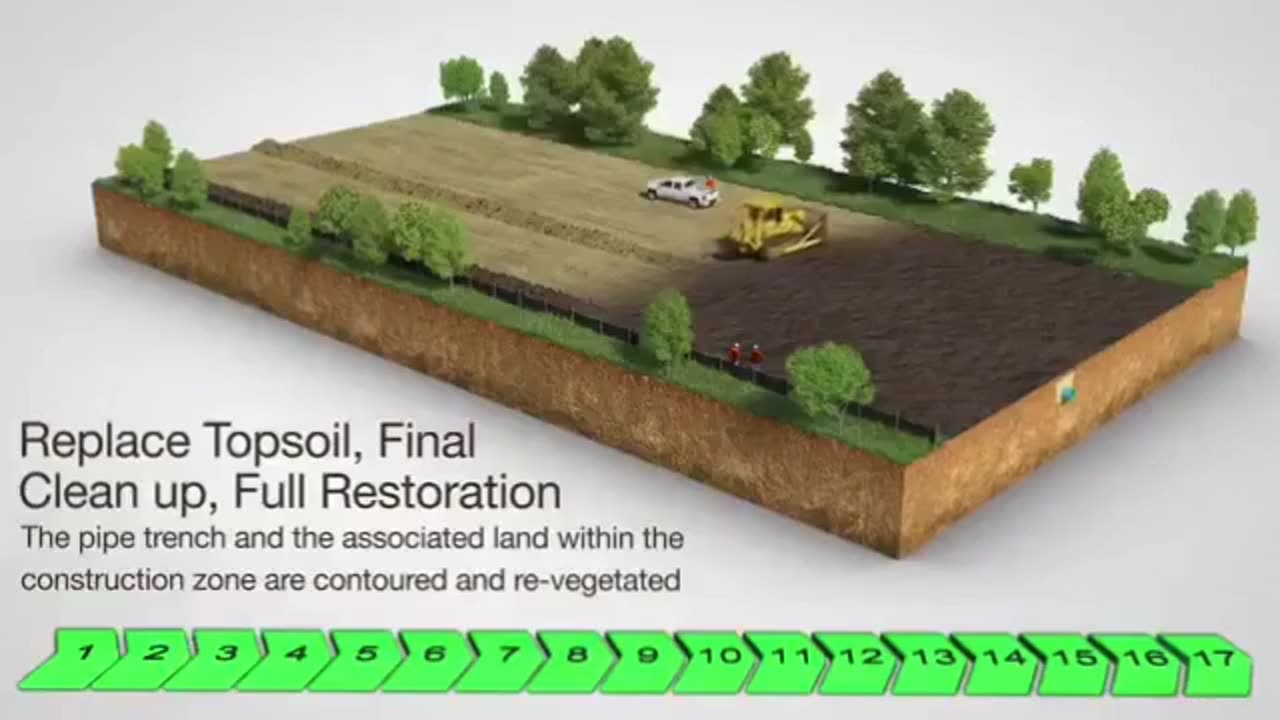Premium Only Content

Typical Pipeline Construction
Typical pipeline construction involves the process of building pipelines to transport various fluids, such as oil, natural gas, water, or chemicals, from one location to another. Here are the key steps and components involved in a typical pipeline construction project:
1. Planning and Design:
- Project Planning: Determine the route and purpose of the pipeline, considering factors like terrain, environmental impact, and regulations.
- Engineering Design: Develop detailed plans and specifications for the pipeline, including size, materials, and pressure requirements.
2. Land Acquisition and Permits:
- Acquire necessary land rights and easements to lay the pipeline across private and public lands.
- Obtain permits and approvals from regulatory authorities and environmental agencies.
3. Clearing and Grading:
- Clear vegetation and prepare the right-of-way for construction.
- Grade the land to create a level and stable foundation for the pipeline.
4. Trenching:
- Excavate a trench along the pipeline route to the required depth and width, ensuring it accommodates the pipeline and provides proper cover.
5. Stringing:
- Place the individual sections of the pipeline (usually made of steel or plastic) along the trench, ready for welding.
6. Welding:
- Weld together the sections of pipe to form a continuous length.
- Inspect and test the welds to ensure they meet quality and safety standards.
7. Coating and Wrapping:
- Apply corrosion-resistant coatings and wrapping to the pipeline to protect it from environmental elements.
8. Lowering the Pipeline:
- Carefully lower the pipeline into the trench, making sure it follows the designed path and alignment.
9. Backfilling:
- Fill the trench with soil, compacting it to provide support and protection for the pipeline.
10. Testing and Inspection:
- Conduct pressure tests to ensure the pipeline is free of leaks and can withstand the intended operating pressure.
- Inspect for compliance with safety and quality standards.
11. Installation of Facilities:
- Install necessary facilities such as valves, pumps, and compressor stations to control and maintain the flow of materials through the pipeline.
12. Restoration:
- Restore the right-of-way by re-vegetating the area and returning it to its original or improved state.
13. Commissioning:
- Test and verify the entire system's functionality.
- Begin operations, transporting the intended materials through the pipeline.
14. Ongoing Maintenance and Monitoring:
- Regularly inspect, maintain, and monitor the pipeline to ensure its safety and integrity over its operational life.
It's important to note that pipeline construction can vary significantly depending on the specific type of pipeline, the materials being transported, and the regulatory and environmental considerations in a given region. Safety and environmental protection are paramount throughout the construction process.
-
 5:12
5:12
Blackstone Griddles
13 hours agoApple Pie Pancakes on the Blackstone Camping Griddle
3.76K1 -
 44:02
44:02
CarlCrusher
23 hours agoFormer Green Beret Mike Battista can Summon UAP using Psionics - Part 4
5.03K5 -
 44:31
44:31
Damon Imani
15 hours agoDamon VS The View | Best of 2025
4.13K4 -
 28:31
28:31
Living Your Wellness Life
17 hours agoShould You Shower Every Day?
6.31K4 -
 1:00:36
1:00:36
A Cigar Hustlers Podcast Every Day
1 day agoHustler Every Week Day Episode 426 "What To Know Before Its To Late!"
3.97K1 -
 LIVE
LIVE
BEK TV
22 hours agoTrent Loos in the Morning - 12/11/2025
156 watching -
 1:34:34
1:34:34
Tucker Carlson
10 hours agoWhy Are We Defending Mass Murder in Gaza? Because Our Greatest Ally Demands It
90.3K405 -
 30:01
30:01
James Klüg
16 hours agoA Murder Capital of America Protests ICE DEPORTING Criminals
12.4K7 -
 26:10
26:10
Michael Knowles
15 hours agoFormer Diddy Escort Reflects on Turning to Christianity | Michael & Shawn Dearing
22.5K13 -
 14:12
14:12
Actual Justice Warrior
2 days agoMamdani Promises To Turn NYC Into San Francisco
20.8K10